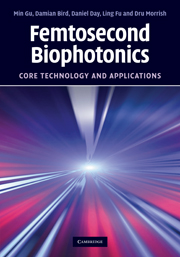Book contents
- Frontmatter
- Contents
- Preface
- 1 Introduction
- 2 Nonlinear optical microscopy
- 3 Two-photon fluorescence microscopy through turbid media
- 4 Fibre-optical nonlinear microscopy
- 5 Nonlinear optical endoscopy
- 6 Trapped-particle near-field scanning optical microscopy
- 7 Femtosecond pulse laser trapping and tweezers
- 8 Near-field optical trapping and tweezers
- 9 Femtosecond cell engineering
- Index
5 - Nonlinear optical endoscopy
Published online by Cambridge University Press: 07 May 2010
- Frontmatter
- Contents
- Preface
- 1 Introduction
- 2 Nonlinear optical microscopy
- 3 Two-photon fluorescence microscopy through turbid media
- 4 Fibre-optical nonlinear microscopy
- 5 Nonlinear optical endoscopy
- 6 Trapped-particle near-field scanning optical microscopy
- 7 Femtosecond pulse laser trapping and tweezers
- 8 Near-field optical trapping and tweezers
- 9 Femtosecond cell engineering
- Index
Summary
Ever since researchers realised that microscopy based on nonlinear optical effects can provide information that is blind to conventional linear techniques, applying nonlinear optical imaging to in vivo medical diagnosis in humans has been the ultimate goal. The development of nonlinear optical endoscopy that permits imaging under conditions in which a conventional nonlinear optical microscope cannot be used is the primary method to extend applications of nonlinear optical microscopy toward this goal. Fibreoptic approaches that allow for remote delivery and collection in a minimally invasive manner are normally used in nonlinear optical endoscopy. In Chapter 4, a compact nonlinear optical microscope based on a single-mode fibre (SMF) coupler to replace complicated bulk optics was described.
There are several key challenges involved in the pursuit of in vivo nonlinear optical endoscopy. First, an excitation laser beam with an ultrashort pulse width should be delivered efficiently to a remote place where efficient collection of faint nonlinear optical signals from biological samples is required. Second, laser-scanning mechanisms adopted in such a miniaturised instrumentation should permit size reduction to a millimetre scale and enable fast scanning rates for monitoring biological processes. Finally, the design of a nonlinear optical endoscope based on micro-optics must maintain great flexibility and compact size to be incorporated into endoscopes to image internal organs.
- Type
- Chapter
- Information
- Femtosecond BiophotonicsCore Technology and Applications, pp. 86 - 115Publisher: Cambridge University PressPrint publication year: 2010



